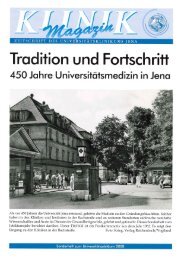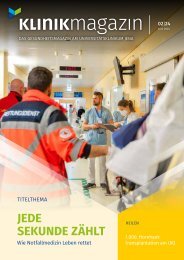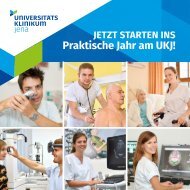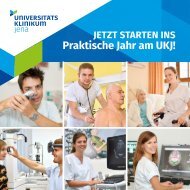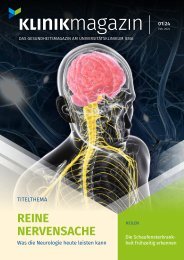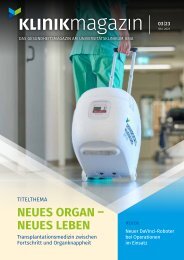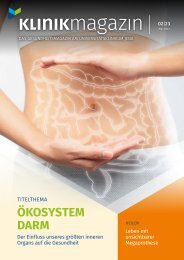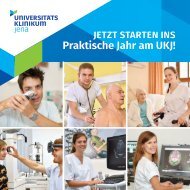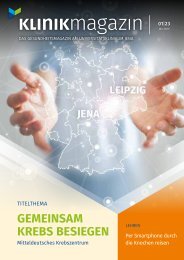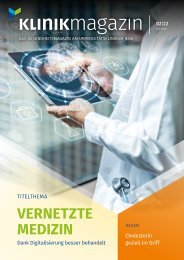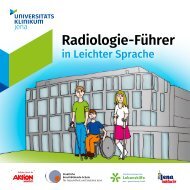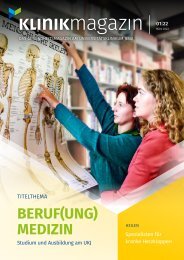Erfolgreiche ePaper selbst erstellen
Machen Sie aus Ihren PDF Publikationen ein blätterbares Flipbook mit unserer einzigartigen Google optimierten e-Paper Software.
Institut für Immunologie<br />
Institute of Immunology<br />
Das Institut für Immunologie hat die Forschungsschwerpunkte<br />
Autoimmunität und Immunregulation. Wir betreiben sowohl<br />
Grundlagenforschung als auch klinisch orientierte Immunologie.<br />
Das Institut für Immunologie ist von der Deutschen Gesellschaft<br />
für Immunologie zur Weiterbildung zum Fachimmunologen ermächtigt.<br />
Im Forschungsschwerpunkt Autoimmunität untersuchen<br />
wir die Induktion, Chronifizierung und Modulation pathogener<br />
Immunantworten bei Arthritis und autoimmuner Enzephalitis.<br />
Hinsichtlich der Immunregulation untersuchen wir vor allem die<br />
Modulation von Immunant-worten durch die sogenannten Th17-<br />
Zellen und den Rezeptor für Interleukin-33.<br />
Direktor: Prof. Dr. med. Thomas Kamradt<br />
Adresse: Leutragraben 3, 07743 Jena<br />
Thomas.Kamradt@mti.uni-jena.de<br />
www.iki.uniklinikum-jena.de<br />
Research at the Institute of Immunology focuses on autoimmunity,<br />
immunoregulation, and infection immunology. Our interest<br />
is both basic research as well as clinically orientated immunology.<br />
In the research focus autoimmunity, we examine the induction,<br />
chronification and modulation of pathological immune responses<br />
in models of arthritis and autoimmune encephalitis. With regard<br />
to immunoregulation we focus on the induction, function and<br />
stability of Th17 cells and the receptor for IL-33.<br />
Forschungsprojekte<br />
Research projects<br />
Osteoimmunologische Interaktionen am Übergang von<br />
akuter zu chronischer Arthritis (Prof. Dr. Thomas Kamradt, Dr.<br />
Oliver Frey), DFG <strong>2010</strong>-2013<br />
In diesem Projekt sollen die von den pathogenen T-Lymphozyten<br />
ausgehenden instruktiven Signale identifiziert; die für die Chronizität<br />
der Arthritis verantwortlichen molekularen Änderungen in<br />
den Effektorzellen charakterisiert; und Strategien gefunden werden,<br />
wie diese therapeutisch moduliert werden können.<br />
Verbund IMPAM, TP 3: Wie wird die Chronische Arthritis<br />
resistent gegen endogene antiinflammatorische Regulation<br />
und wie kann man chronische Arthritis dennoch<br />
kontrollieren? (Prof. Dr. Thomas Kamradt), BMBF <strong>2010</strong>-2013<br />
Verbundziel ist die interdisziplinäre Erforschung der molekularen<br />
Interaktionen zwischen Zellen des Immunsystems und mesenchymalen<br />
Zellen im Gelenk, die zur Pathogenese der chronischen Arthritis<br />
beitragen und die therapeutische Modulation dieser Interaktionen.<br />
Im TP 3 wollen wir herausfinden, zu welchen Zeitpunkten<br />
der Arthritis-Pathogenese (Induktion, Effektor-Phase, Remission)<br />
Immunmodulation durch regulatorische T-Lymphozyten (Treg)<br />
klinisch relevant ist und durch welche molekularen Mechanismen<br />
diese Immunmodulation vermittelt wird. Die Antworten auf diese<br />
Fragen sind deshalb von Relevanz, weil sie es erlauben, die klinische<br />
Modulation von Treg (Modulation, Transfer) gezielt dann durchzuführen,<br />
wenn diese Zellen für die Pathogenese bedeutsam sind.<br />
Verbund Neuroimmunverbindungen bei Entzündung und<br />
Schmerz, TP 6: Neuroimmunmodulation der Arthritis<br />
(Prof. Dr. Thomas Kamradt), BMBF <strong>2010</strong>-2013<br />
Verbundziel ist die Erforschung der Bedeutung der Interaktion<br />
zwischen Immun-und Nervensystem für Entzündung und Schmerz.<br />
Im TP 6 erforschen wir die neuronalen und immunologischen Mechanismen<br />
der Neuro-Immunmodulation der Arthritis.<br />
Pathogenetische und protektive Funktionen von B-Lymphozyten<br />
bei G6PI-induzierter Arthritis<br />
(Prof. Dr. Thomas Kamradt), DFG 2008-2011<br />
B-Lymphozyten sind für die Pathogenese entzündlicher Erkrankungen<br />
wichtig. Eine zentrale Frage lautet: Welche Funktion der B-Zellen<br />
ist pathogenetisch relevant? Neben der Antikörperproduktion<br />
kommen hier u.a. die Fähigkeiten der B-Lymphozyten zur Antigenpräsentation,<br />
Ko-Stimulation und Zytokinproduktion in Frage.<br />
Dies wird in einem Mausmodell der Arthritis untersucht. B-Zellen<br />
werden zu unterschiedlichen Zeitpunkten der Arthritis-Pathogenese<br />
depletiert. Mit geeigneten knockout-Mäusen und Antikörpern<br />
werden bestimmte Funktionen der B-Zellen gezielt blockiert.<br />
PET/CT zur Darstellung von Infektion und Entzündung:<br />
Reduction, Refinement und Replacement von Tierversuchen<br />
(Prof. Dr. Thomas Kamradt), BMBF 2008-2011<br />
Ersatz der in murinen Arthritismodellen für die Bewertung von<br />
Entzündung und Destruktion verwendeten histopathologischen<br />
und immunhistochemischen Methoden durch die nicht-invasive<br />
18F-FDG-Positronen-Emissions-Tomographie/Computer-Tomographie<br />
(PET/CT)-In vivo-Bildgebung (Abb.)<br />
Abb: µCT-Aufnahme der Hinterpfote einer Maus mit chronischer<br />
G6PI-Arthritis. A, In hochauflösenden CT-Aufnahmen der Hinterpfote<br />
einer Maus mit fortgeschrittener G6PI-Arthritis zeigen sich<br />
erosive Läsionen an den Oberflächen der Gelenkknochen (Pfeile).<br />
B, Durch Oberflächenrenderung lassen sich Bereiche mit pathologischen<br />
Veränderungen der Knochenoberfläche identifizieren.<br />
C, Bereiche mit verringerter Dichte des Knochens werden in der<br />
Volumenrenderung dunkel dargestellt.<br />
Fig: µCT imaging of a mouse hind paw with chronic G6PI arthritis.<br />
A, High resolution CT imaging of a mouse hind paw reveals erosive<br />
lesions in the stage of advanced G6PI arthritis (arrows).<br />
B, Surface rendering allows identification of areas with pathological<br />
alterations of bone surface.<br />
C, Reduction of bone density is visualized by volume rendering.<br />
Weitere Projekte<br />
Funktion von regulatorischen T-Lymphozyten bei der<br />
Modulation autoimmuner Attacken auf das ZNS - Untersuchungen<br />
anhand des Tiermodells EAE<br />
(Dr. Sylvia Heink)<br />
Osteoimmunological Interactions at the Switch from<br />
Acute to Chronic Arthritis<br />
We aim at defining the instructive signals from pathogenic T-lymphocytes,<br />
identify and characterise the molecular alternations in<br />
the effector cells responsible for non-remitting destructive arthritis<br />
and find ways to modulate them.<br />
Imprinting of the Pathogenic Memory for Rheumatic Inflammation,<br />
TP 3: How does arthritic inflammation escape<br />
immunoregulation and which opportunities exist to<br />
regain control<br />
The principal objective of this project is to understand when and<br />
how regulatory T cells (Treg) impinge on the pathogenesis of arthritis.<br />
We will use novel reagents which allow for the first time<br />
to deplete or transfer Tregs specifically at exactly defined time<br />
points during the course of arthritis. Based on our earlier work<br />
the hypothesis which will be tested experimentally is, that Tregs<br />
influence the development of effector/memory Th cells only very<br />
early during the course of an immune response. If this is the case,<br />
the key to regaining control over inflammation in diseases such<br />
as RA would not be to add Tregs back (as is currently aimed at in<br />
a number of clinical and pre-clinical studies) but rather to identify<br />
and subsequently modulate those elements of the pathogenic<br />
immune response, which dominate when Treg control has failed.<br />
The planned experimental work will therefore consist of selective<br />
depletion of Treg at different time points during arthritis pathogenesis.<br />
Complementing this approach, we will adoptively transfer<br />
Treg into arthritic or pre-arthritic animals. The transgenic mousemodel<br />
employed allows for the selective transfer of either naive<br />
or antigen-experienced Treg, which means that we will be able to<br />
assess the relevance of the Tregs‘ prior history for their effector<br />
function. Finally, we will assess if Tregs can regulate joint resident<br />
cells (fibroblast like synovial cells, osteoclasts) in addition to regulating<br />
Th cells.<br />
Neuroimmune connections in inflammation and pain,<br />
TP 6: Neuro-Immunomodulation of Arthritis<br />
Aim of the consortium: investigation into the importance of the<br />
interaction between the immune system and the nervous system<br />
in inflammation and pain. Aim of subproject 6: Research into the<br />
neuronal and immunological mechanisms of neuro-immunomodulation<br />
of arthritis.<br />
Further projects<br />
Capacity of regulatory T-lymphocytes to influence autoimmune<br />
attacks on the brain – examination of different<br />
EAE models<br />
Pathogenic and protective functions of B-lymphocytes<br />
in G6Pi-induced arthritis<br />
B-Lymphocytes are essential in the pathogenesis of inflammatory<br />
diseases. A central question thereby is: Through which function do<br />
B-lymphocytes contribute to the pathogenesis? They can either be<br />
involved through the production of (auto-)antibodies, through antigen<br />
presentation, co-stimulation or through the production of<br />
cytokines. This is currently investigated in an animal model for the<br />
human autoimmune disease Rheumatoid Arthritis, the Glucose-6-<br />
-Phosphate-Isomerase induced arthritis model. After arthritis induction<br />
in susceptible mouse strains, we are depleting the B cells<br />
at different time points in the course of the disease. By using appropriate<br />
knock out mice or by applicating specific antibodies, the<br />
different functions, through which B lymphocytes may contribute<br />
to the pathogenesis, are specifically inhibited and can thereby be<br />
analysed.<br />
PET/CT for non-invasive monitoring of joint inflammation.<br />
Reduction, refinement and replacement of animal<br />
experimentation<br />
Replacement of histopathological and immunohistochemical methods<br />
used for inflammation and destruction assessment in murine<br />
arthritis models by non-invasive 18F-FDG F-18 positron emission<br />
tomography computed tomography imaging in vivo (Fig.)<br />
Publications<br />
• Drube S, et al. The receptor tyrosine kinase c-Kit controls IL-33<br />
receptor signaling in mast cells. Blood. <strong>2010</strong>, 115:3899-906<br />
• Irmler IM, et al. In vivo molecular imaging of experimental<br />
joint inflammation by combined 18F-FDG positron emission<br />
tomography and computed tomography. Arthritis Res Ther.<br />
<strong>2010</strong>, 12:R203<br />
• Frey O, et al. Inducible costimulator (ICOS) blockade inhibits<br />
accumulation of polyfunctional T helper 1/T helper 17 cells and<br />
mitigates autoimmune arthritis. Ann Rheum Dis. <strong>2010</strong>, 69:1495-<br />
501<br />
• Frey O, et al. Regulatory T cells control the transition from acute<br />
into chronic inflammation in glucose-6-phosphate isomeraseinduced<br />
arthritis. Ann Rheum Dis. <strong>2010</strong>, 69:1511-8.<br />
• Muñoz M, et al. Interleukin (IL)-23 mediates Toxoplasma gondiiinduced<br />
immunopathology in the gut via matrixmetalloproteinase-2<br />
and IL-22 but independent of IL-17. J Exp Med.<br />
<strong>2009</strong>, 206:3047-59.<br />
28|29



